1994 CHEVROLET CAVALIER ESP
[x] Cancel search: ESPPage 146 of 243
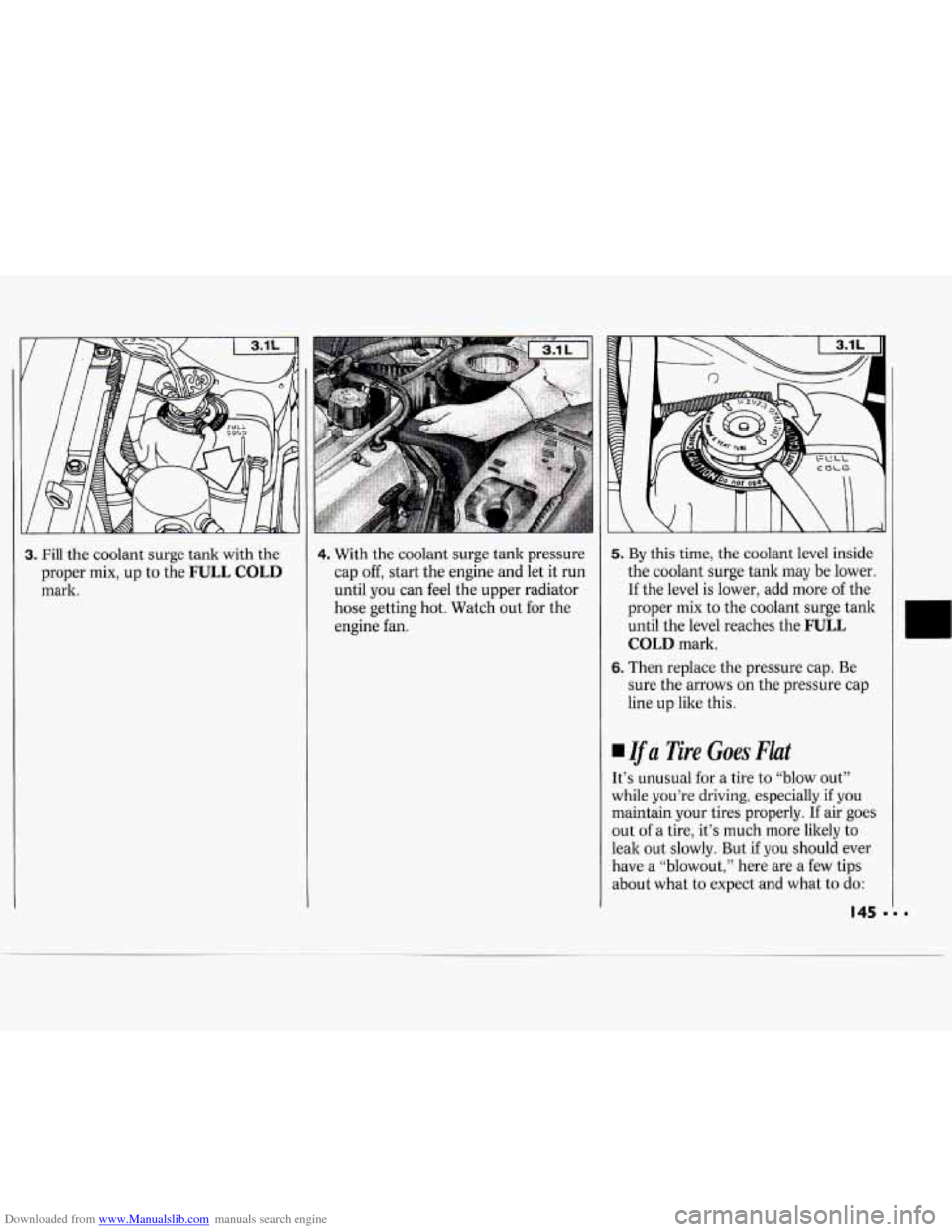
Downloaded from www.Manualslib.com manuals search engine 3. Fill the coolant surge tank with the
proper mix, up to the
FULL COLD
mark.
4. With the coolant surge tank pressure
cap
off, start the engine and let it run
until you can feel the upper radiator
hose getting hot. Watch out for the
engine fan.
5. By this time, the coolant level inside
the coolant surge tank may be lower.
If the level is lower, add more of the
proper mix to the coolant surge tank
until the level reaches the
FULL
COLD mark.
6. Then replace the pressure cap. Be
sure the arrows
on the pressure cap
line up like this.
Ifa Tire Goes Flat
It’s unusual for a tire to “blow out”
while you’re driving, especially
if you
maintain your tires properly. If air goes
out of a tire, it’s much more likely to
leak out slowly. But
if you should ever
have a
blowout^" here are a few tips
about what to expect and what
to do:
Page 156 of 243
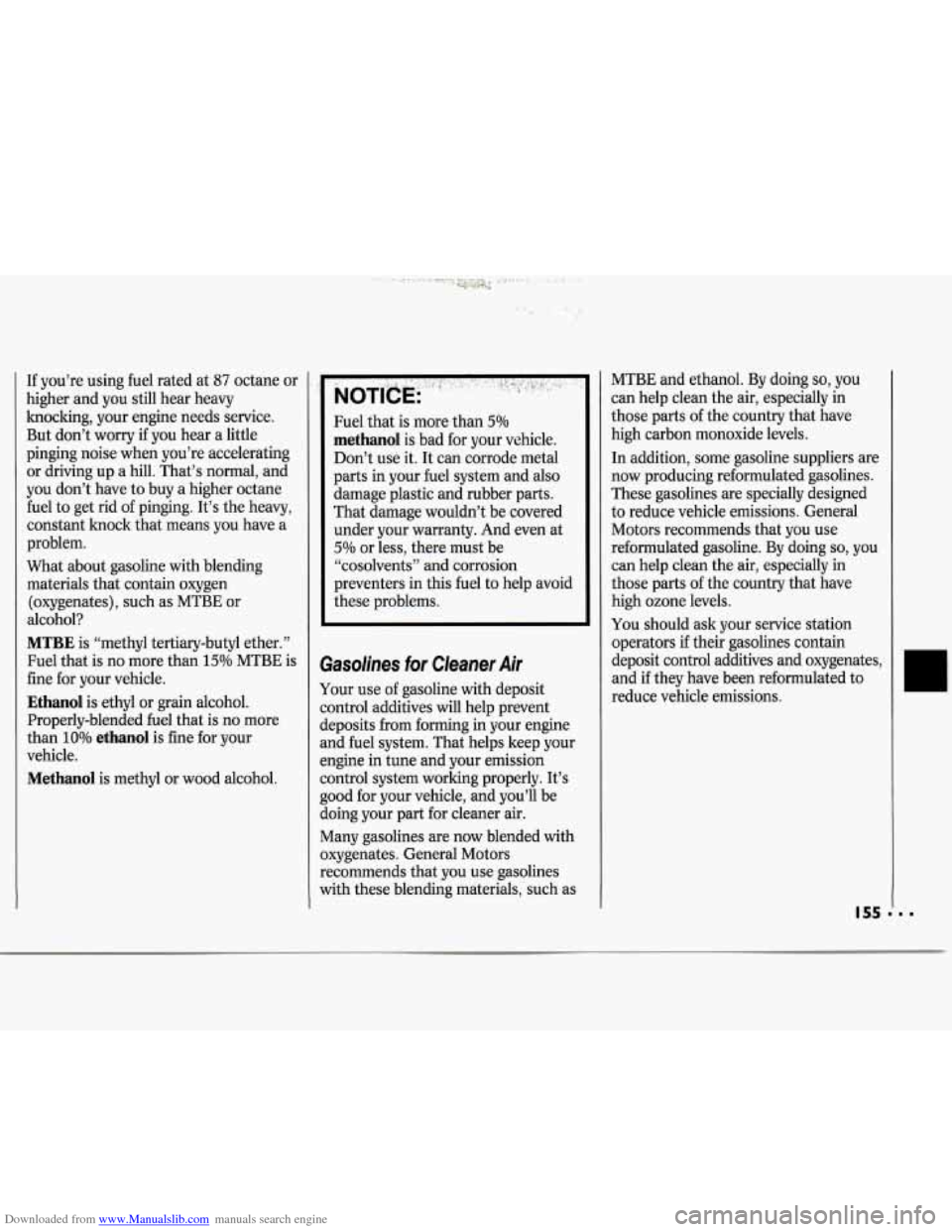
Downloaded from www.Manualslib.com manuals search engine If you’re using fuel rated at 87 octane or
higher and you still hear heavy
knocking, your engine needs service.
But don’t worry
if you hear a little
pinging noise when you’re accelerating
or driving up a hill. That’s normal, and
you don’t have to buy a higher octane
fuel to get rid of pinging. It’s the heavy,
constant knock that means you have a
problem.
What about gasoline with blending
materials that contain oxygen
(oxygenates), such as MTBE or
alcohol?
MTBE is “methyl tertiary-butyl ether.”
Fuel that is no more than
15% MTBE is
fine for your vehicle.
Ethanol is ethyl or grain alcohol.
Properly-blended fuel that is no more
than
10% ethanol is fine for your
vehicle.
Methanol is methyl or wood alcohol. Fuel
that is more than
5%
methanol is bad for your vehicle.
Don’t use it. It can corrode metal
parts in your fuel system and also
damage plastic and rubber parts.
That damage wouldn’t be covered
under your warranty. And even at
5% or less, there must be
“cosolvents” and corrosion
preventers in this fuel to help avoid
these problems.
Gasolines for Cleaner Air
Your use of gasoline with deposit
control additives will help prevent
deposits from forming in your engine
and fuel system. That helps keep your
engine in tune and your emission
control system working properly. It’s
good for your vehicle, and you’ll be
doing your part for cleaner air.
Many gasolines are now blended with
oxygenates. General Motors
recommends that you use gasolines
with these blending materials, such as
MTBE and ethanol. By doing so, you
can help clean the air, especially in
those parts of the country that have
high carbon monoxide levels.
In addition, some gasoline suppliers are
now producing reformulated gasolines.
These gasolines are specially designed
to reduce vehicle emissions. General
Motors recommends that you use
reformulated gasoline. By doing
so, you
can help clean the air, especially in
those parts of the country that have
high ozone levels.
You should ask your service station
operators if their gasolines contain
deposit control additives and oxygenates,
and if they have been reformulated to
reduce vehicle emissions.
Page 168 of 243
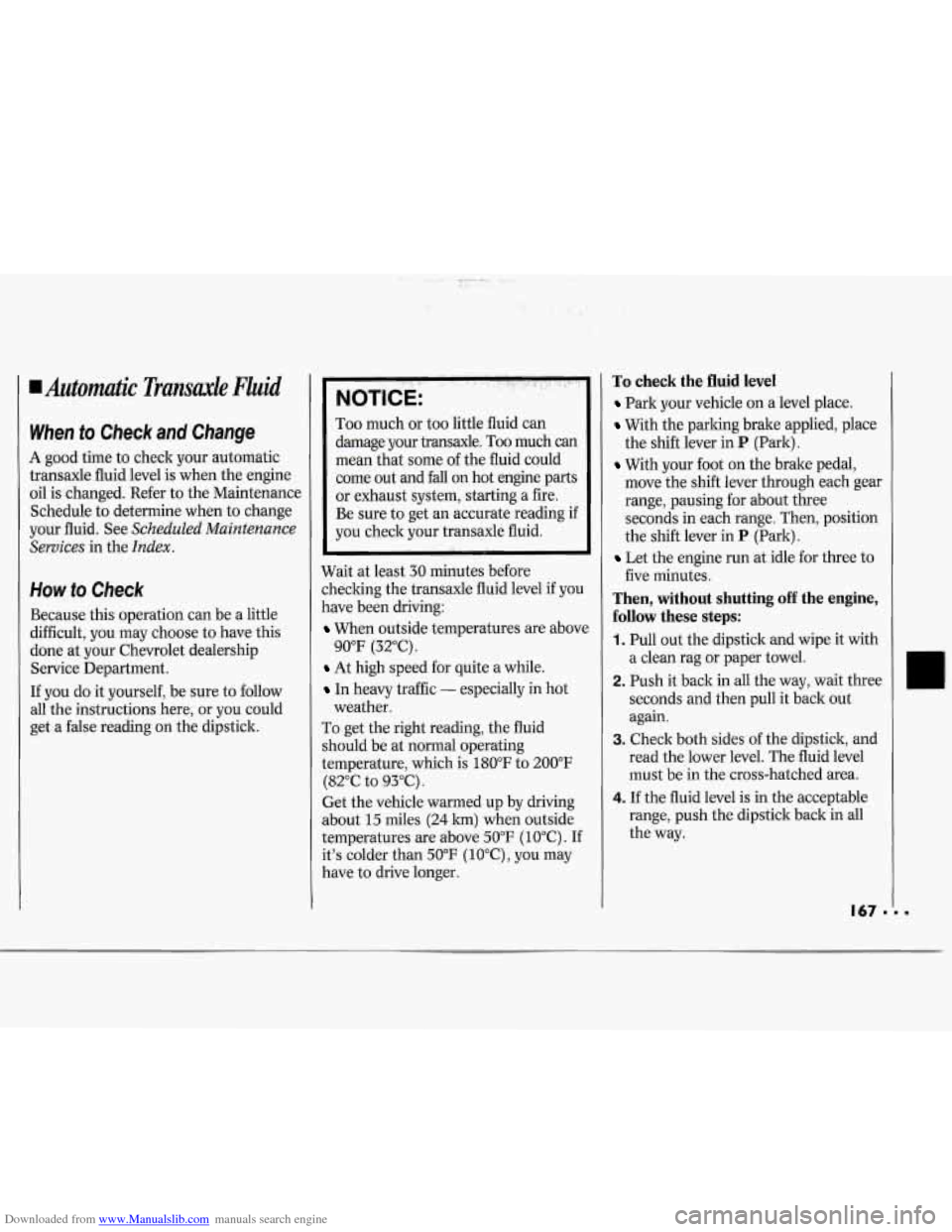
Downloaded from www.Manualslib.com manuals search engine I Automatic Transaxle Fluid
1 When to Check and Change
A good time to check your automatic
transaxle fluid level is when the engine
oil is changed. Refer to the Maintenance
Schedule to determine when to change
your fluid. See
Scheduled Maintenance
Services
in the Index.
How to Check
Because this operation can be a little
difficult, you may choose to have this
done at your Chevrolet dealership
Service Department.
If you do it yourself, be sure to follow
all the instructions here, or
you could
get a false reading on the dipstick.
NOTICE:
~. , ,'
Too much or too little fluid can
damage your transaxle.
Too much can
mean that some of the fluid could
come out and fall on hot engine parts
or exhaust system, starting a fire.
Be sure to get an accurate reading
if
you check your transaxle fluid.
Wait at least
30 minutes before
checking the transaxle fluid level
if you
have been driving:
When outside temperatures are above
At high speed for quite a while.
In heavy traffic - especially in hot
To get the right reading, the fluid
should be at normal operating
temperature, which is 180°F to 200°F
(82°C to 93°C).
Get the vehicle warmed up by driving
about 15 miles (24 lun) when outside
temperatures are above
50°F (10.C). If
it's colder than 50°F (lOOC), you may
have to drive longer.
90°F
(32°C).
weather.
To check the fluid level
Park your vehicle on a level place.
With the parking brake applied, place
With your foot on the brake pedal,
the
shift lever in
P (Park).
move the shift lever through each gear
range, pausing for about three
seconds in each range. Then, position
the shift lever in
P (Park).
Let the engine run at idle for three to
five minutes.
Then, without shutting off the engine,
follow these steps:
1. Pull out the dipstick and wipe it with
2. Push it back in all the way, wait three
a clean rag or
paper towel.
seconds and then pull it back out
again.
3. Check both sides of the dipstick, and
read the lower level. The fluid level
must be in the cross-hatched area.
4. If the fluid level is in the acceptable
range, push the dipstick back in all
the way.
Page 169 of 243
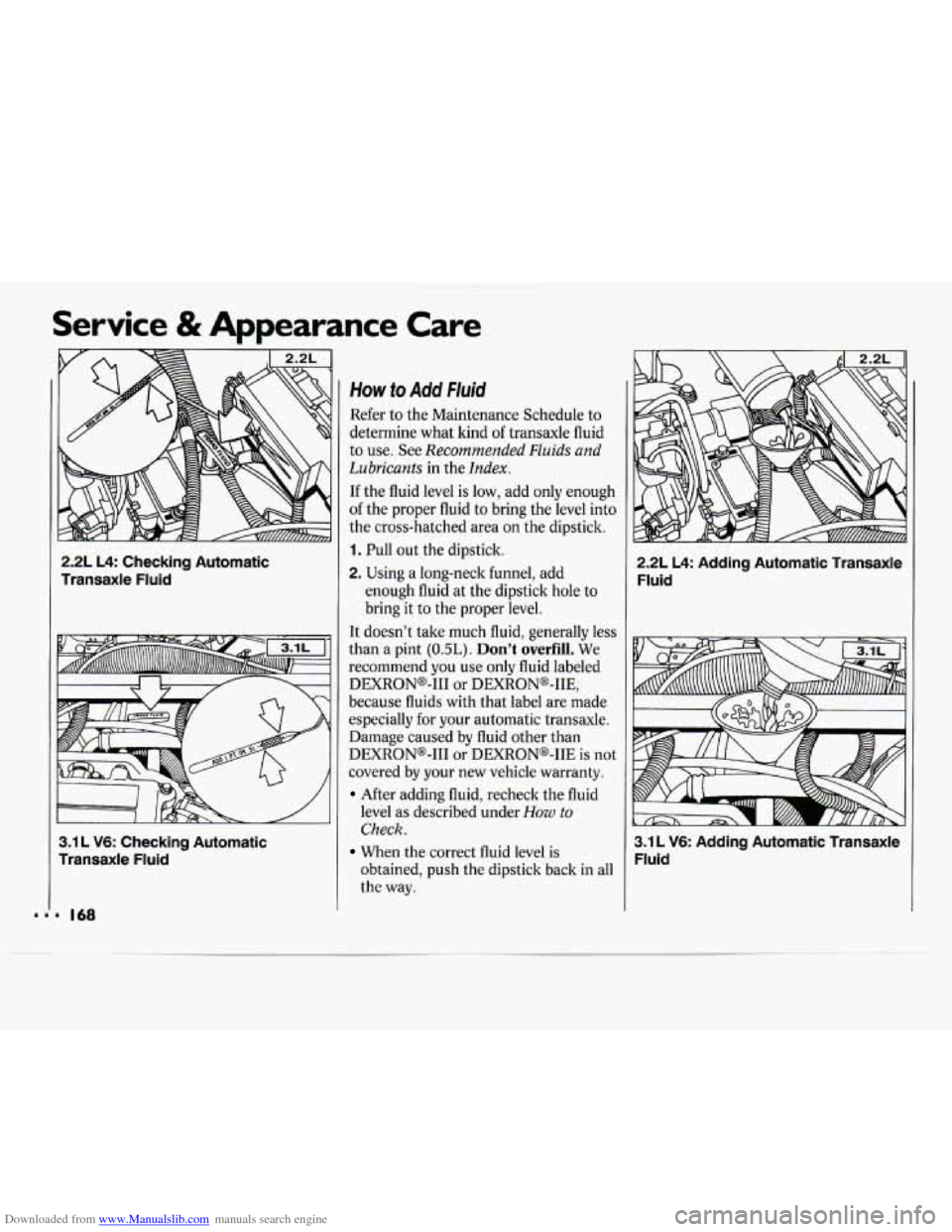
Downloaded from www.Manualslib.com manuals search engine Service & Appearance Care
2.2L L4: Checking Automatic
Transaxle Fluid
3.1 L V6: Checking Automatic
Transaxle Fluid
. 168
How to Add fluid
Refer to the Maintenance Schedule to
determine what kind of transaxle fluid
to use. See
Recommended Fluids and
Lubricants in the Index.
If the fluid level is low, add only enough
of the proper fluid to bring the level into
the cross-hatched area
on the dipstick.
1. Pull out the dipstick.
2. Using a long-neck funnel, add
enough fluid at the dipstick hole
to
bring it to the proper level.
It doesn’t take much fluid, generally less
than a pint
(0.5L). Don’t overfill. We
recommend you use only fluid labeled
DEXRONo-111 or DEXRONB-HE,
because fluids with that label are made
especially for your automatic transaxle.
Damage caused by fluid other than
DEXRONO-I11
or DEXRONB-IIE is not
covered by your new vehicle warranty.
After adding fluid, recheck the fluid
level as described under
How to
Check.
obtained, push the dipstick back in all
the way.
When the correct fluid level is
2.2L L4: Adding Automatic Transaxle
Fluid
3.1 L V6: Adding Automatic Transaxle
Fluid
Page 184 of 243
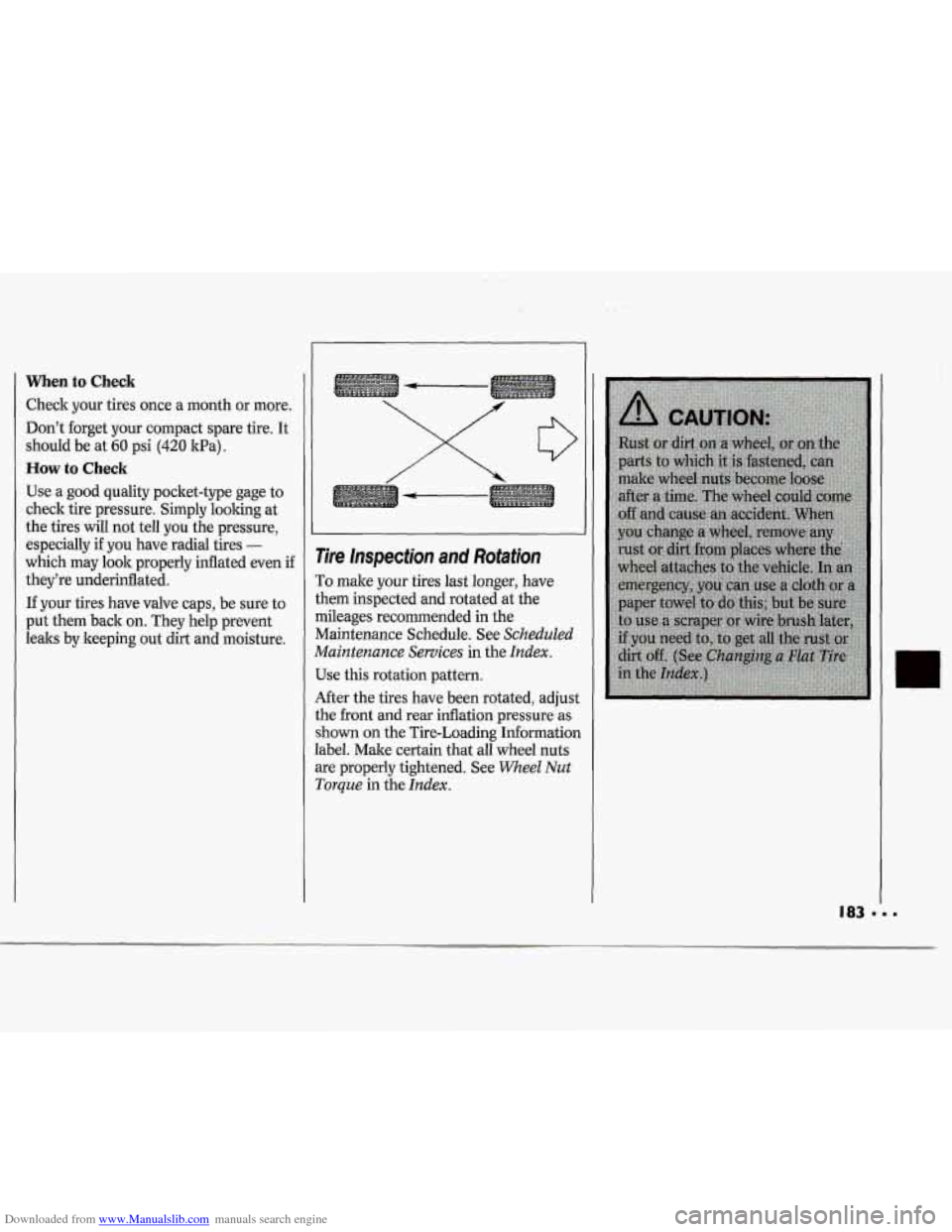
Downloaded from www.Manualslib.com manuals search engine When to Check
Check your tires once a month or more.
Don't forget your compact spare tire. It
should be at
60 psi (420 1tPa).
How to Check
Use a good quality pocket-type gage to
check tire pressure. Simply looking at
the tires
will not tell you the pressure,
especially if you have radial tires
-
which may look properly inflated even if
they're underinflated.
If your tires have valve caps, be sure to
put them back on. They help prevent
leaks by keeping out dirt and moisture.
x
Tire lnspection and Rotation
To make your tires last longer, have
them inspected and rotated at the
mileages recommended in the
Maintenance Schedule. See
Scheduled
Maintenance Services
in the Index.
Use this rotation pattern.
After the tires have been rotated, adjust
the front and rear inflation pressure as
shown on the Tire-Loading Information
label. Make certain that all wheel nuts
are properly tightened. See
Wheel Nut
Torque in the Index.
Page 186 of 243
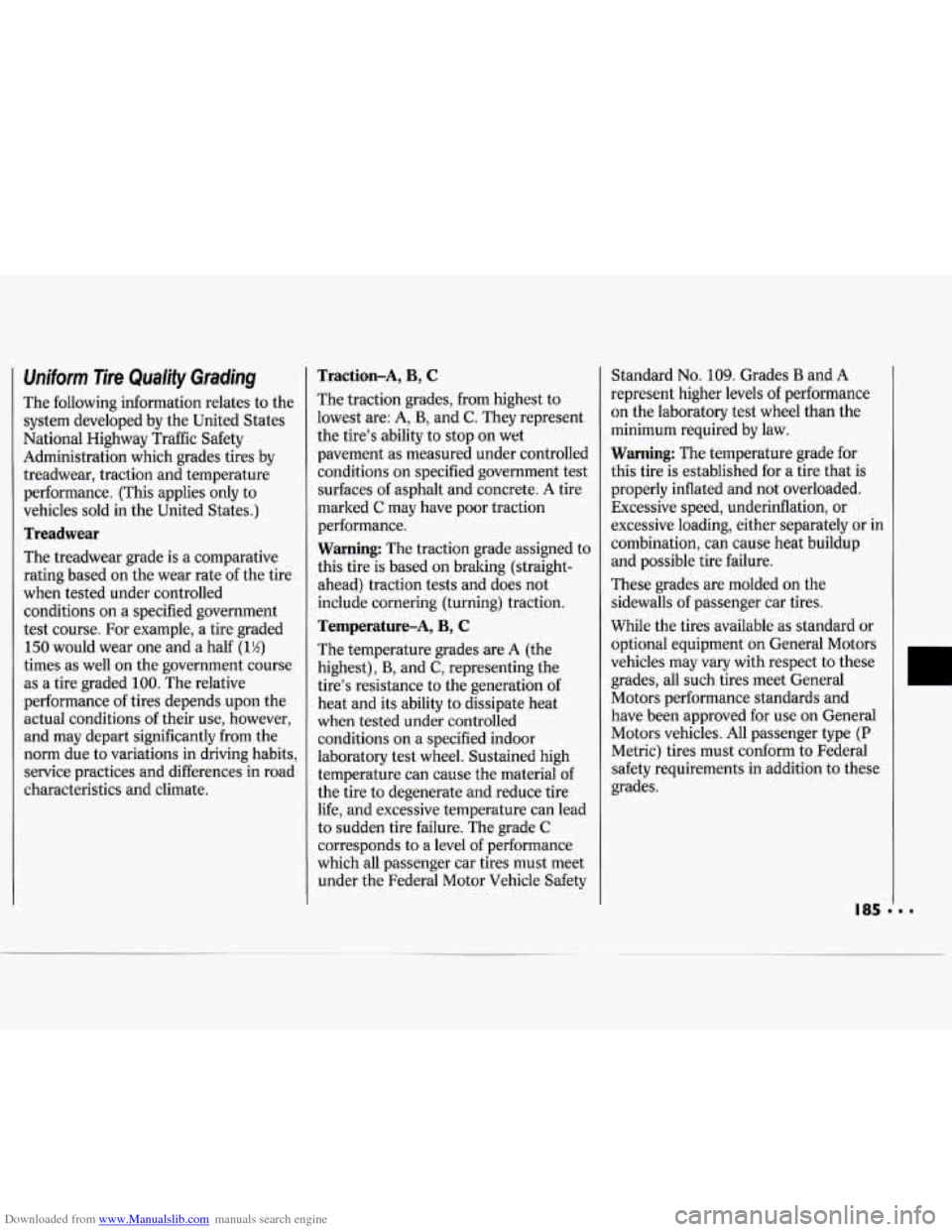
Downloaded from www.Manualslib.com manuals search engine Uniform Tire Qualify Grading
The following information relates to the
system developed by the United States
National Highway Traffic Safety
Administration which grades tires by
treadwear, traction and temperature
performance. (This applies only to
vehicles sold in the United States.)
Treadwear
The treadwear grade is a comparative
rating based on the wear rate
of the tire
when tested under controlled
conditions on a specified government
test course. For example, a tire graded
150 would wear one and a half (1 Yz)
times as well on the government course
as a tire graded
100. The relative
performance of tires depends upon the
actual conditions
of their use, however,
and may depart significantly from the
norm due to variations in driving habits,
service practices and differences in road
characteristics and climate.
Traction-A, B, C
The traction grades, from highest to
lowest are: A,
B, and C. They represent
the tire’s ability to stop on wet
pavement as measured under controlled
conditions on specified government test
surfaces
of asphalt and concrete. A tire
marked
C may have poor traction
performance.
Warning: The traction grade assigned to
this tire
is based on braking (straight-
ahead) traction tests and does not
include cornering (turning) traction.
Temperature-A, B, C
The temperature grades are A (the
highest),
B, and C, representing the
tire’s resistance to the generation
of
heat and its ability to dissipate heat
when tested under controlled conditions on a specified indoor
laboratory test wheel. Sustained high
temperature can cause the material of
the tire to degenerate and reduce tire
life, and excessive temperature can lead
to sudden tire failure. The grade
C
corresponds to a level of performance
which all passenger car tires must meet
under the Federal Motor Vehicle Safety Standard
No.
109. Grades B and A
represent higher levels
of performance
on the laboratory test wheel than the
minimum required by law.
Warning: The temperature grade for
this tire is established for a tire that is
properly inflated and not overloaded.
Excessive speed, underinflation, or
excessive loading, either separately or in
combination, can cause heat buildup
and possible tire failure.
These grades are molded on the
sidewalls of passenger car tires.
While the tires available as standard or
optional equipment
on General Motors
vehicles may vary with respect to these
grades, all such tires meet General
Motors performance standards and
have been approved for use on General
Motors vehicles. All passenger type
(P
Metric) tires must conform to Federal
safety requirements in addition to these
grades.
1
Page 220 of 243
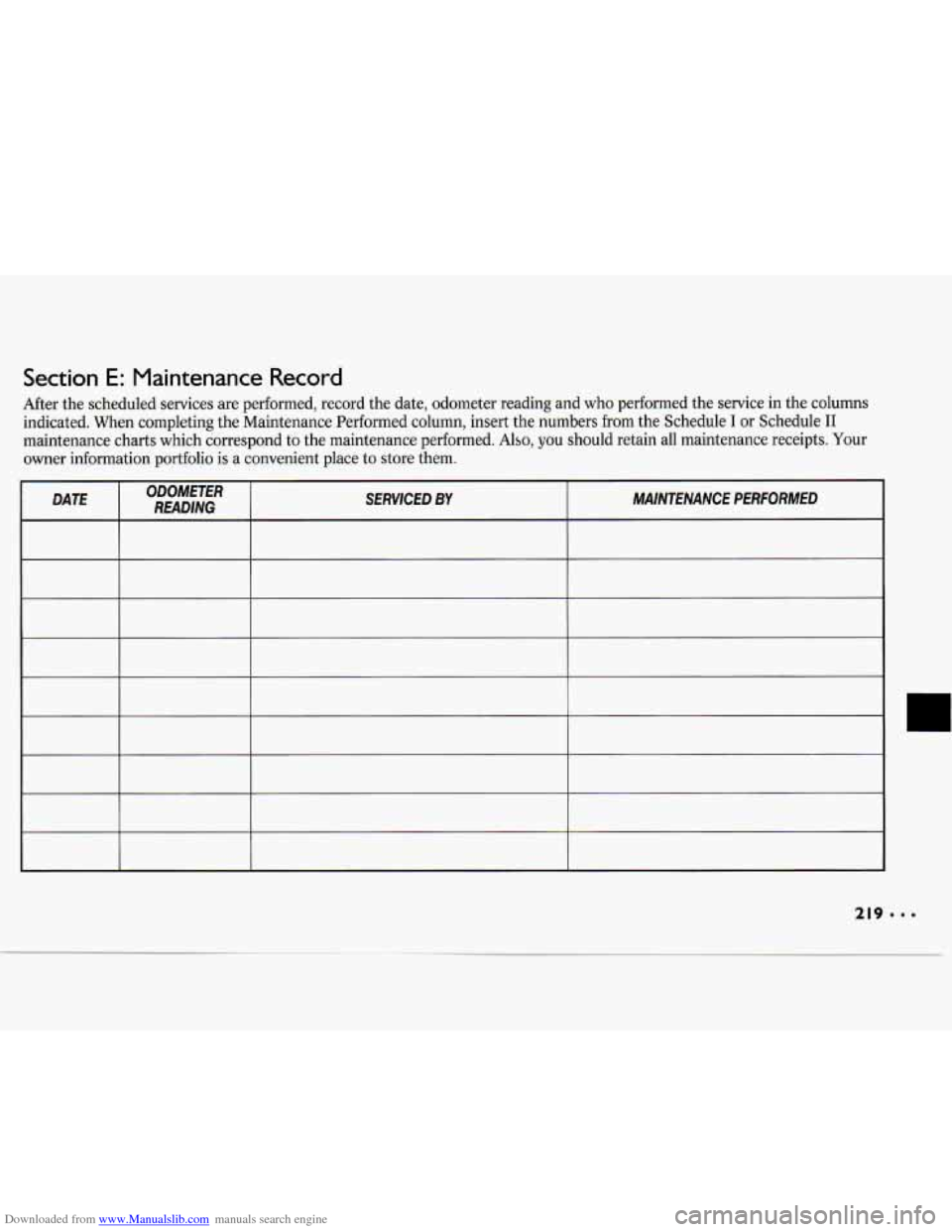
Downloaded from www.Manualslib.com manuals search engine Section E: Maintenance Record
After the scheduled services are performed, record the date, odometer reading and who performed the service in the columns
indicated. When completing the Maintenance Performed column, insert the numbers from the Schedule
I or Schedule I1
maintenance charts which correspond to the maintenance performed. Also, you should retain all maintenance receipts. Your
owner information portfolio
is a convenient place to store them.
DATE ODOMETER
READING SERVICED BY MAINTENANCE PERFORMED
Page 223 of 243
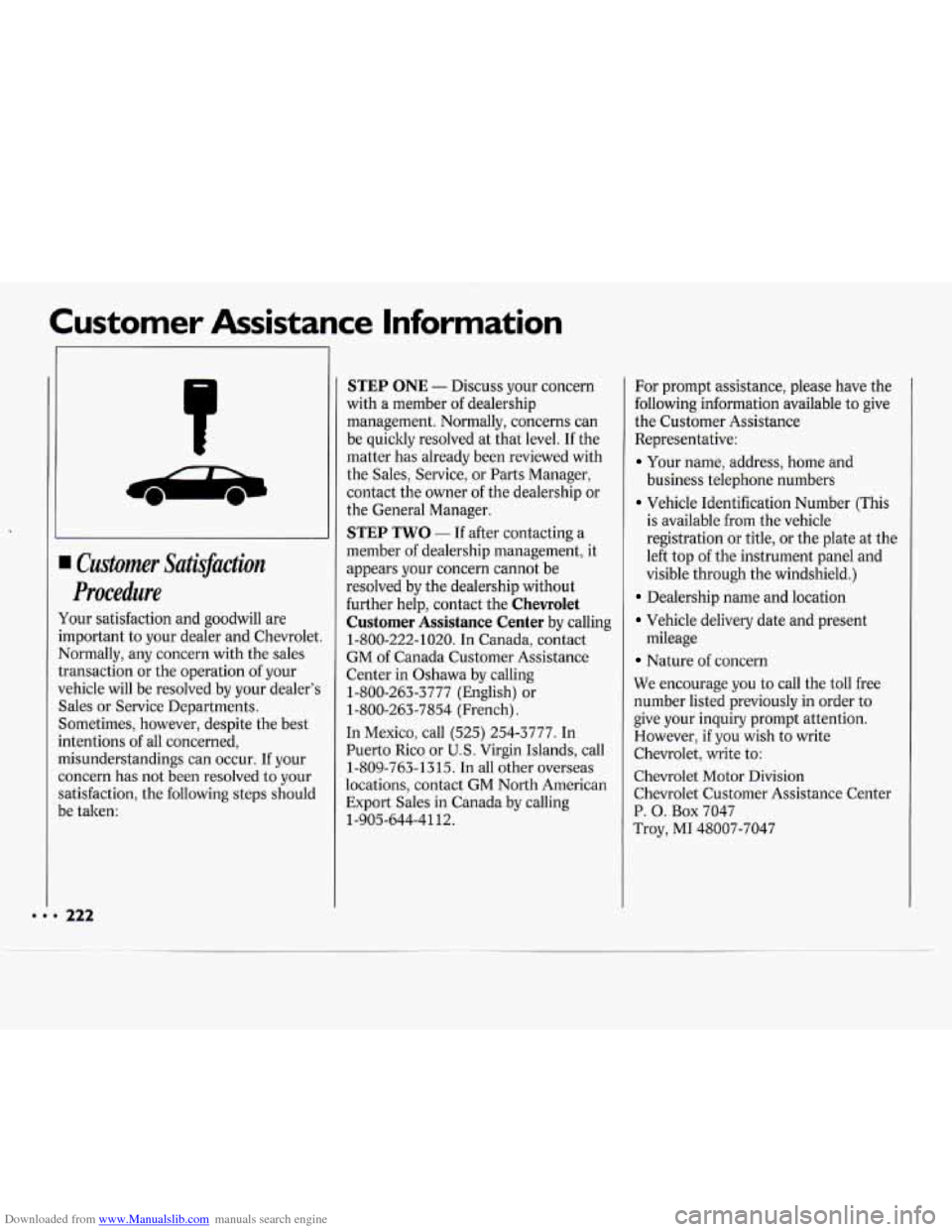
Downloaded from www.Manualslib.com manuals search engine Customer Assistance Information
Customer Sati#action
Procedure
Your satisfaction and goodwill are
important to your dealer and Chevrolet.
Normally, any concern with the sales
transaction or the operation of your
vehicle will be resolved by yo1
Sales or Service Departments
Sometimes, however, despite
intentions of all concerned,
misunderstandings can occur concern has not been resolve(
1:
t r-dealer’s
he best
If your
to your
satisfaction, the following steps should
be taken:
STEP ONE - Discuss your concern
with a member of dealership
management. Normally, concerns can
be quicltly resolved at that level.
If the
matter has already been reviewed with
the Sales, Service,
or Parts Manager,
contact the owner of the dealership or
the General Manager.
STEP TWO - If after contacting a
member
of dealership management, it
appears your concern cannot be
resolved by the dealership without
further help, contact the
Chevrolet
Customer Assistance Center
by calling
1-800-222-1020.
In Canada, contact
GM of Canada Customer Assistance
Center in Oshawa by calling
1-800-263-3777 (English) or
1-800-263-7854 (French).
In Mexico, call (525) 254-3777. In
Puerto Rico or
U.S. Virgin Islands, call
1-809-763-1315. In all other overseas
locations, contact
GM North American
Export Sales in Canada by calling
1-905-644-4112. For prompt assistance, please have
the
following information available to give
the Customer Assistance
Representative:
Your name, address, home and
business telephone numbers
Vehicle Identification Number (This
is available from the vehicle
registration or title, or the plate at the
left top of the instrument panel and
visible through the windshield.)
Dealership name and location
Vehicle delivery date and present
Nature of concern
We encourage you
to call the toll free
number listed previously in order to
give your inquiry prompt attention.
However,
if you wish to write
Chevrolet, write to:
Chevrolet Motor Division
Chevrolet Customer Assistance Center
P.
0. Box 7047
Troy,
MI 48007-7047
mileage